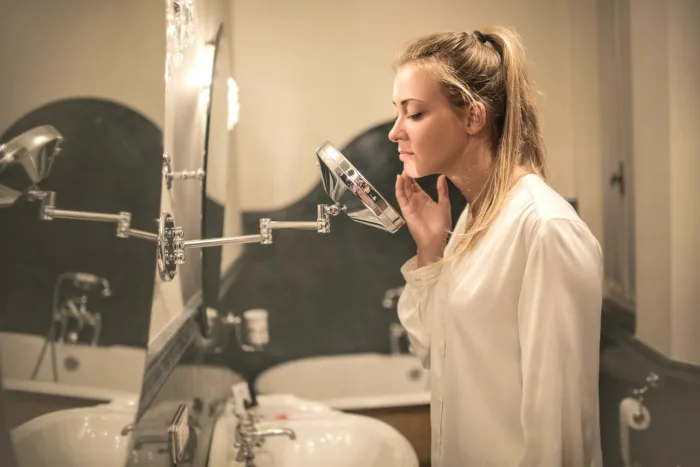Oily Skin and Hormonal Acne

While many people experience acne during their lifetime, the type of acne which they suffer from can vary. Hormonal acne is a quite common type experienced by acne sufferers. Hormonal acne is not caused by lifestyle choices such as over-washing the skin or disturbing the skin’s moisture barrier, but rather occurs as the result of hormonal fluctuations in the body. Hormonal breakouts tend to be located on the lower half of the face, typically along the jawline. The type of blemishes associated with hormonal acne are not simple whiteheads or blackheads but inflammatory acne. One type of inflammatory acne related to hormonal fluctuation is cystic acne[1] that is deep within the skin’s second layer and can be very painful. Post-inflammatory hyperpigmentation and scarring are also commonly linked to hormonal acne.
Causes
There are many hormonally-driven causes of acne in general, as androgenic hormone stimulation results in the increase of sebaceous secretion[2] (oil production) during certain phases in life such as puberty, particularly for teenage boys. However, the general use of the term “hormonal acne” is mostly used to describe adult acne in women and occasionally adult men who also suffer from hormonal imbalances. Women who often experience hormonal acne do so under certain circumstances and for a variety of reasons[3] such as stress, after starting or stopping birth control pills as well as other medications, a fluctuation in certain hormone levels during the menstrual cycle, pregnancy dietary sensitivities, and hormonal disorders such as PCOS[4]. Men who have fathers who experience hormonal acne[5] are also more likely to experience it.
The Role of Androgens in Acne
The role of androgens[6] in the cause and development of acne is well established. Testosterone, Dehydroepiandrosterone Sulfate (SDHEA) and Dihydrotestosterone (DHT) stimulate the growth of the skin’s oil glands and subsequently, the production of oil. The sebaceous glands rely upon the body’s estrogen and androgen levels remaining in balance in order to function properly. Birth control pills[7], that contain both estrogen and progesterone or progestin, are often used to treat hormonal acne because they actually reduce functional androgen levels and in turn, hinder their ability to stimulate oil production. The use of these pills to treat acne is common in adult women and is also why it is more difficult to treat hormonal acne in men, as the same treatments are not available.
Other Hormones
The sebaceous gland is a complex neuroendocrine organ[8], meaning it receives neuronal input and, as a result of this input, releases hormones. However, sebaceous glands are not just passive endocrine target organs that react to androgens and estrogens. Production of sebum can also be stimulated by neuropeptides and other hormones such as melanocortins and corticotropin-releasing hormone[9], which leads to acne breakouts during periods of stress.
Many people also find that certain foods such as dairy, gluten, and foods with a high glycemic load[10] tend to trigger hormonal breakouts. Dairy foods and high glycemic load foods raise insulin and IGF1 levels[11] and if these get too high, they can cause increased oil production. Although both of these hormones are made within the body and are necessary for bodily function, those who are sensitive to these hormones will find that having high levels can give rise to hormone imbalances and acne breakouts.
Treating Hormonal Acne
While there are many contributing factors to hormonal acne, it remains an ongoing issue for many adults, particularly women. Oftentimes, multiple treatments are needed to see relief when treating hormonal acne and the typical over-the-counter acne treatments are not sufficient in solving hormonal acne issues. Your dermatologist may suggest beginning your treatment by eliminating certain dietary elements such as simple sugars, gluten, dairy, and processed foods, though this may not be enough for most patients to eliminate or control their acne entirely.
Treatments such as prescription retinoids, topical antibiotics like clindamycin, and anti-inflammatories may be recommended to treat hormonal acne, generally in conjunction with a cleanser that contains certain ingredients such as salicylic acid or benzoyl peroxide. However, many women find more success with hormonal treatments such as an oral birth control pill, as was mentioned earlier. Another oral medication that can be given to both men and women is spironolactone. Spironolactone[12] is a blood pressure medication that blocks androgen hormone receptors in the skin and when taken in low dosages, can help to treat hormonal acne.
If you are suffering with hormonal acne or suspect that you may be experiencing hormonal acne, make an appointment with a certified dermatologist for a diagnosis and to discuss treatment options.